Accounting Theory & Contemporary Issues: A Report for ACC301
VerifiedAdded on 2022/11/13
|8
|1609
|138
Report
AI Summary
This report analyzes the International Accounting Standards Board's (IASB) revised conceptual framework for financial reporting, issued in March 2018. The report addresses the framework's objectives, including providing relevant information for stakeholders, and discusses the definitions of assets, liabilities, expenses, income, and equity. It also examines the concept of prudence, also known as the principle of conservatism, and asymmetrical prudence, highlighting how these concepts impact financial statements. Additionally, the report explores the concept of substance over form, emphasizing the importance of representing the true economic value of transactions. The report incorporates a video transcript that summarizes the key points of the written analysis and provides a comprehensive overview of the contemporary accounting issues.
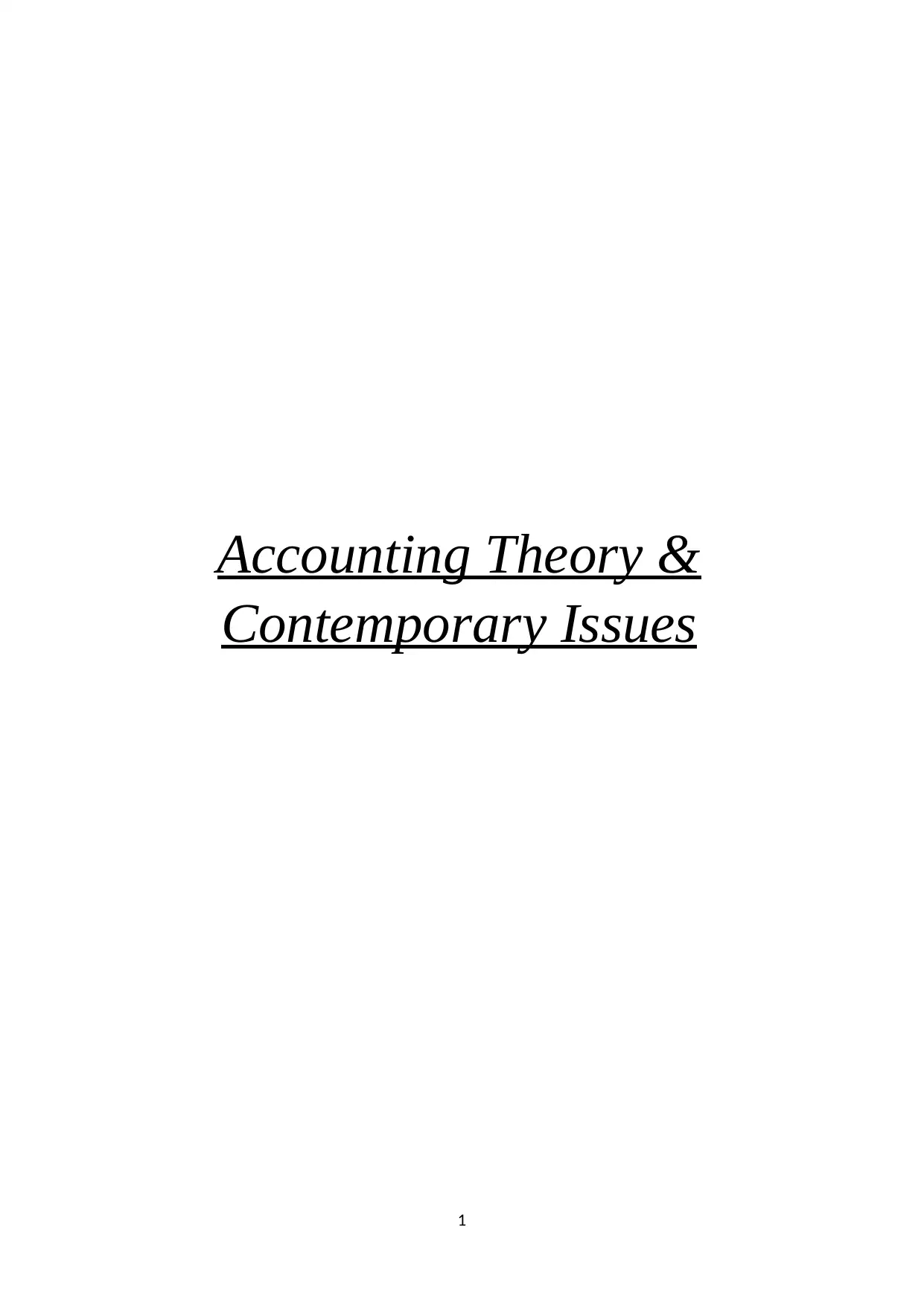
Accounting Theory &
Contemporary Issues
1
Contemporary Issues
1
Paraphrase This Document
Need a fresh take? Get an instant paraphrase of this document with our AI Paraphraser
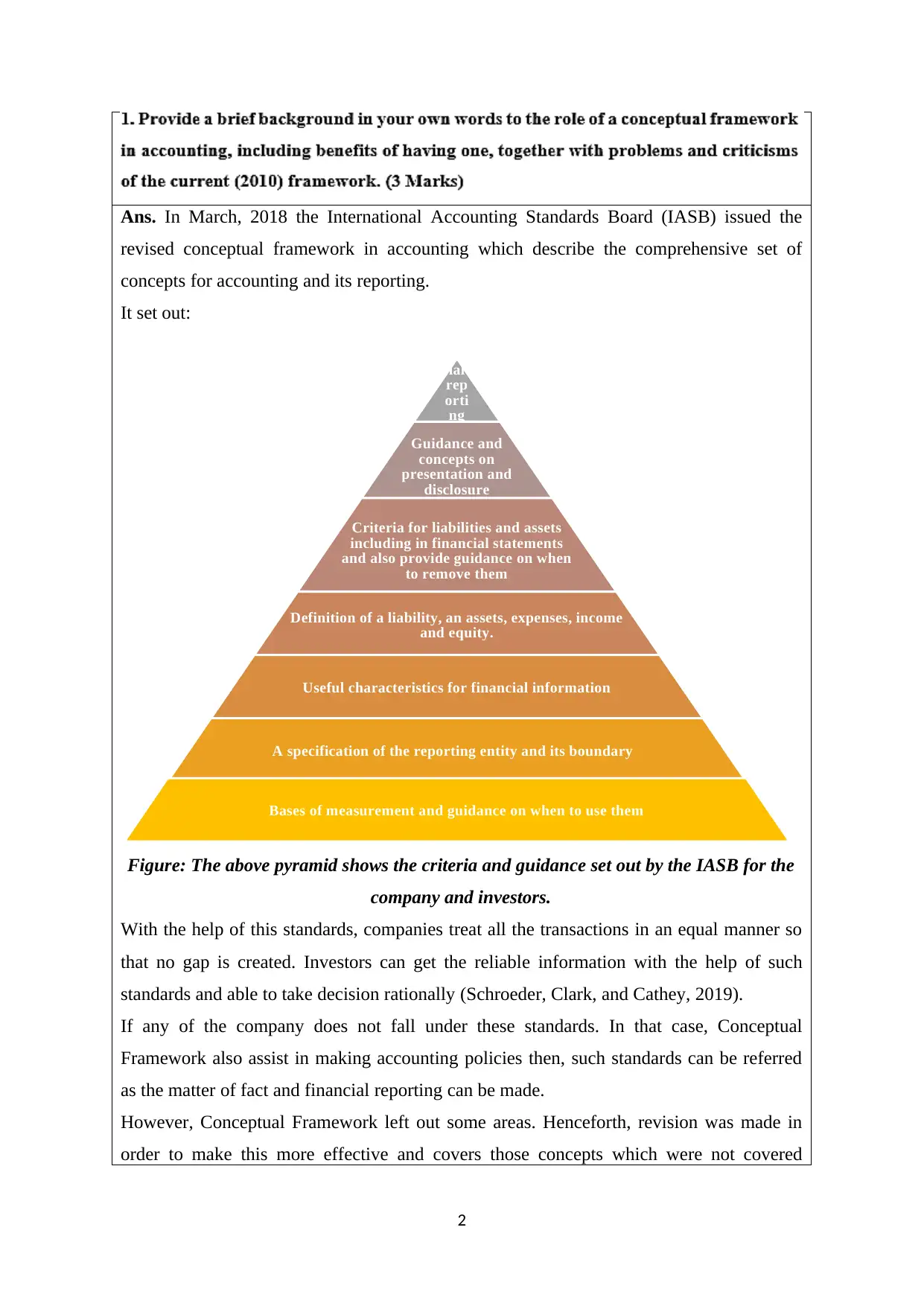
Ans. In March, 2018 the International Accounting Standards Board (IASB) issued the
revised conceptual framework in accounting which describe the comprehensive set of
concepts for accounting and its reporting.
It set out:
Figure: The above pyramid shows the criteria and guidance set out by the IASB for the
company and investors.
With the help of this standards, companies treat all the transactions in an equal manner so
that no gap is created. Investors can get the reliable information with the help of such
standards and able to take decision rationally (Schroeder, Clark, and Cathey, 2019).
If any of the company does not fall under these standards. In that case, Conceptual
Framework also assist in making accounting policies then, such standards can be referred
as the matter of fact and financial reporting can be made.
However, Conceptual Framework left out some areas. Henceforth, revision was made in
order to make this more effective and covers those concepts which were not covered
2
Fin
anc
ial
rep
orti
ng
obj
ecti
ves
Guidance and
concepts on
presentation and
disclosure
Criteria for liabilities and assets
including in financial statements
and also provide guidance on when
to remove them
Definition of a liability, an assets, expenses, income
and equity.
Useful characteristics for financial information
A specification of the reporting entity and its boundary
Bases of measurement and guidance on when to use them
revised conceptual framework in accounting which describe the comprehensive set of
concepts for accounting and its reporting.
It set out:
Figure: The above pyramid shows the criteria and guidance set out by the IASB for the
company and investors.
With the help of this standards, companies treat all the transactions in an equal manner so
that no gap is created. Investors can get the reliable information with the help of such
standards and able to take decision rationally (Schroeder, Clark, and Cathey, 2019).
If any of the company does not fall under these standards. In that case, Conceptual
Framework also assist in making accounting policies then, such standards can be referred
as the matter of fact and financial reporting can be made.
However, Conceptual Framework left out some areas. Henceforth, revision was made in
order to make this more effective and covers those concepts which were not covered
2
Fin
anc
ial
rep
orti
ng
obj
ecti
ves
Guidance and
concepts on
presentation and
disclosure
Criteria for liabilities and assets
including in financial statements
and also provide guidance on when
to remove them
Definition of a liability, an assets, expenses, income
and equity.
Useful characteristics for financial information
A specification of the reporting entity and its boundary
Bases of measurement and guidance on when to use them
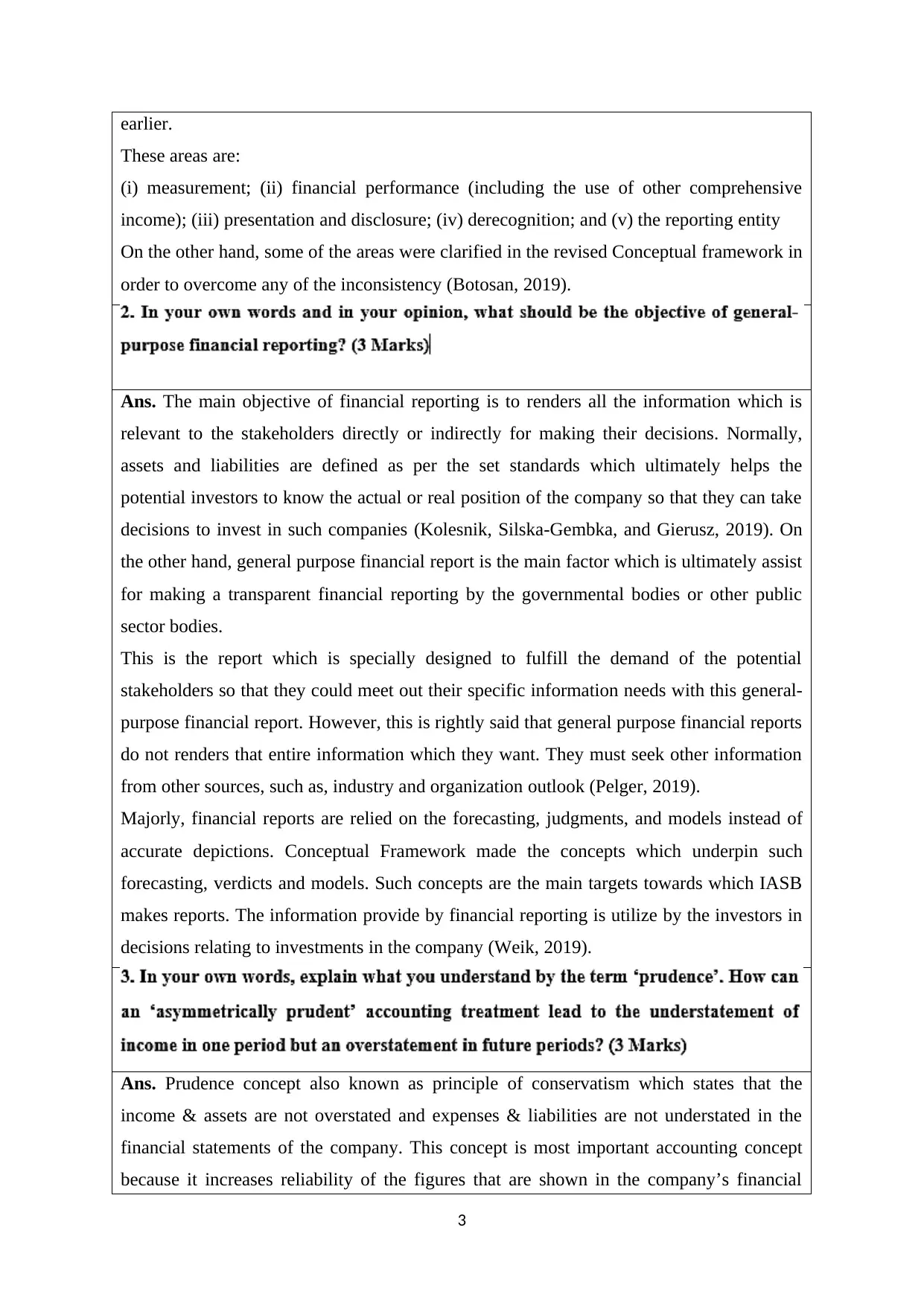
earlier.
These areas are:
(i) measurement; (ii) financial performance (including the use of other comprehensive
income); (iii) presentation and disclosure; (iv) derecognition; and (v) the reporting entity
On the other hand, some of the areas were clarified in the revised Conceptual framework in
order to overcome any of the inconsistency (Botosan, 2019).
Ans. The main objective of financial reporting is to renders all the information which is
relevant to the stakeholders directly or indirectly for making their decisions. Normally,
assets and liabilities are defined as per the set standards which ultimately helps the
potential investors to know the actual or real position of the company so that they can take
decisions to invest in such companies (Kolesnik, Silska-Gembka, and Gierusz, 2019). On
the other hand, general purpose financial report is the main factor which is ultimately assist
for making a transparent financial reporting by the governmental bodies or other public
sector bodies.
This is the report which is specially designed to fulfill the demand of the potential
stakeholders so that they could meet out their specific information needs with this general-
purpose financial report. However, this is rightly said that general purpose financial reports
do not renders that entire information which they want. They must seek other information
from other sources, such as, industry and organization outlook (Pelger, 2019).
Majorly, financial reports are relied on the forecasting, judgments, and models instead of
accurate depictions. Conceptual Framework made the concepts which underpin such
forecasting, verdicts and models. Such concepts are the main targets towards which IASB
makes reports. The information provide by financial reporting is utilize by the investors in
decisions relating to investments in the company (Weik, 2019).
Ans. Prudence concept also known as principle of conservatism which states that the
income & assets are not overstated and expenses & liabilities are not understated in the
financial statements of the company. This concept is most important accounting concept
because it increases reliability of the figures that are shown in the company’s financial
3
These areas are:
(i) measurement; (ii) financial performance (including the use of other comprehensive
income); (iii) presentation and disclosure; (iv) derecognition; and (v) the reporting entity
On the other hand, some of the areas were clarified in the revised Conceptual framework in
order to overcome any of the inconsistency (Botosan, 2019).
Ans. The main objective of financial reporting is to renders all the information which is
relevant to the stakeholders directly or indirectly for making their decisions. Normally,
assets and liabilities are defined as per the set standards which ultimately helps the
potential investors to know the actual or real position of the company so that they can take
decisions to invest in such companies (Kolesnik, Silska-Gembka, and Gierusz, 2019). On
the other hand, general purpose financial report is the main factor which is ultimately assist
for making a transparent financial reporting by the governmental bodies or other public
sector bodies.
This is the report which is specially designed to fulfill the demand of the potential
stakeholders so that they could meet out their specific information needs with this general-
purpose financial report. However, this is rightly said that general purpose financial reports
do not renders that entire information which they want. They must seek other information
from other sources, such as, industry and organization outlook (Pelger, 2019).
Majorly, financial reports are relied on the forecasting, judgments, and models instead of
accurate depictions. Conceptual Framework made the concepts which underpin such
forecasting, verdicts and models. Such concepts are the main targets towards which IASB
makes reports. The information provide by financial reporting is utilize by the investors in
decisions relating to investments in the company (Weik, 2019).
Ans. Prudence concept also known as principle of conservatism which states that the
income & assets are not overstated and expenses & liabilities are not understated in the
financial statements of the company. This concept is most important accounting concept
because it increases reliability of the figures that are shown in the company’s financial
3
⊘ This is a preview!⊘
Do you want full access?
Subscribe today to unlock all pages.

Trusted by 1+ million students worldwide
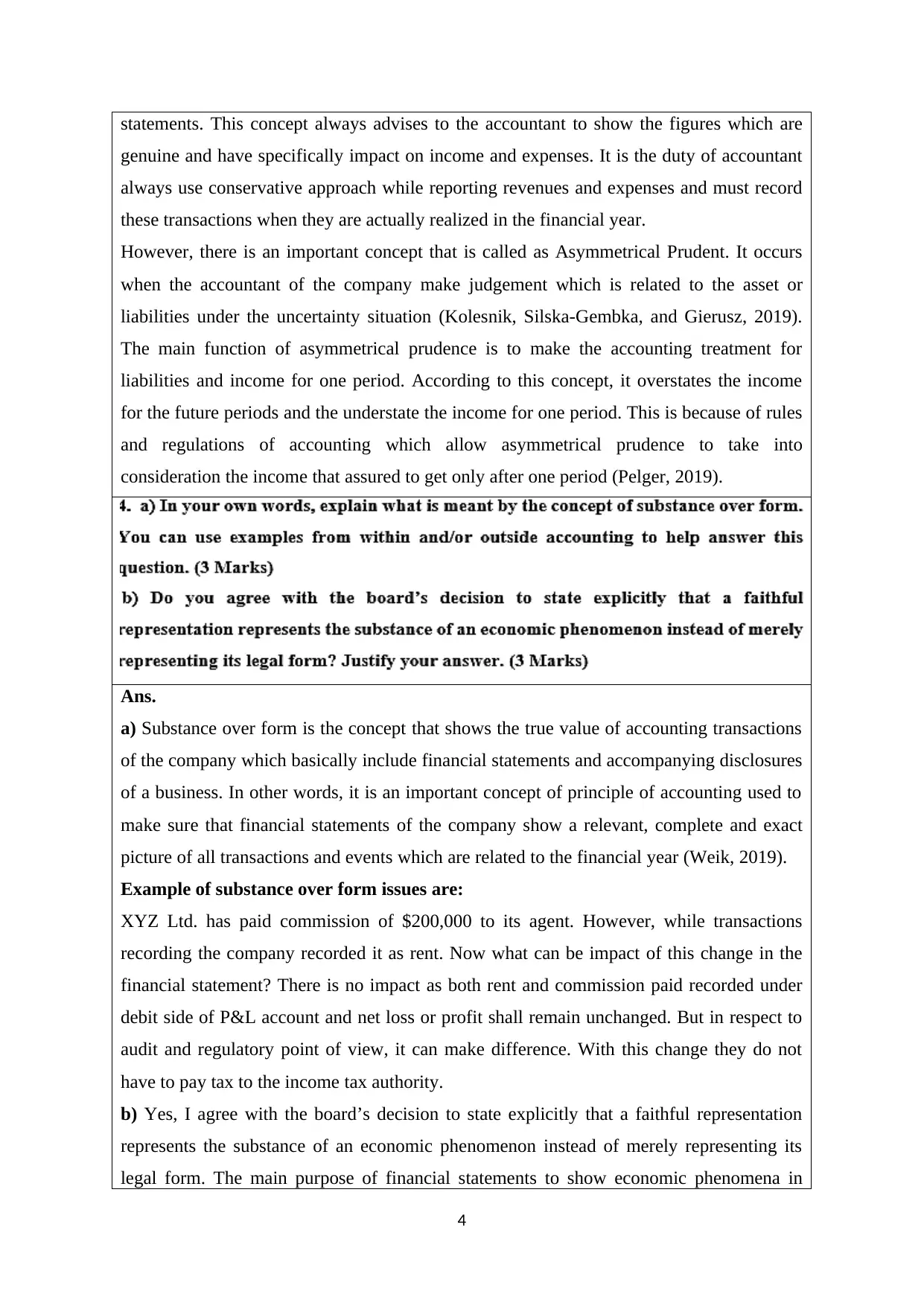
statements. This concept always advises to the accountant to show the figures which are
genuine and have specifically impact on income and expenses. It is the duty of accountant
always use conservative approach while reporting revenues and expenses and must record
these transactions when they are actually realized in the financial year.
However, there is an important concept that is called as Asymmetrical Prudent. It occurs
when the accountant of the company make judgement which is related to the asset or
liabilities under the uncertainty situation (Kolesnik, Silska-Gembka, and Gierusz, 2019).
The main function of asymmetrical prudence is to make the accounting treatment for
liabilities and income for one period. According to this concept, it overstates the income
for the future periods and the understate the income for one period. This is because of rules
and regulations of accounting which allow asymmetrical prudence to take into
consideration the income that assured to get only after one period (Pelger, 2019).
Ans.
a) Substance over form is the concept that shows the true value of accounting transactions
of the company which basically include financial statements and accompanying disclosures
of a business. In other words, it is an important concept of principle of accounting used to
make sure that financial statements of the company show a relevant, complete and exact
picture of all transactions and events which are related to the financial year (Weik, 2019).
Example of substance over form issues are:
XYZ Ltd. has paid commission of $200,000 to its agent. However, while transactions
recording the company recorded it as rent. Now what can be impact of this change in the
financial statement? There is no impact as both rent and commission paid recorded under
debit side of P&L account and net loss or profit shall remain unchanged. But in respect to
audit and regulatory point of view, it can make difference. With this change they do not
have to pay tax to the income tax authority.
b) Yes, I agree with the board’s decision to state explicitly that a faithful representation
represents the substance of an economic phenomenon instead of merely representing its
legal form. The main purpose of financial statements to show economic phenomena in
4
genuine and have specifically impact on income and expenses. It is the duty of accountant
always use conservative approach while reporting revenues and expenses and must record
these transactions when they are actually realized in the financial year.
However, there is an important concept that is called as Asymmetrical Prudent. It occurs
when the accountant of the company make judgement which is related to the asset or
liabilities under the uncertainty situation (Kolesnik, Silska-Gembka, and Gierusz, 2019).
The main function of asymmetrical prudence is to make the accounting treatment for
liabilities and income for one period. According to this concept, it overstates the income
for the future periods and the understate the income for one period. This is because of rules
and regulations of accounting which allow asymmetrical prudence to take into
consideration the income that assured to get only after one period (Pelger, 2019).
Ans.
a) Substance over form is the concept that shows the true value of accounting transactions
of the company which basically include financial statements and accompanying disclosures
of a business. In other words, it is an important concept of principle of accounting used to
make sure that financial statements of the company show a relevant, complete and exact
picture of all transactions and events which are related to the financial year (Weik, 2019).
Example of substance over form issues are:
XYZ Ltd. has paid commission of $200,000 to its agent. However, while transactions
recording the company recorded it as rent. Now what can be impact of this change in the
financial statement? There is no impact as both rent and commission paid recorded under
debit side of P&L account and net loss or profit shall remain unchanged. But in respect to
audit and regulatory point of view, it can make difference. With this change they do not
have to pay tax to the income tax authority.
b) Yes, I agree with the board’s decision to state explicitly that a faithful representation
represents the substance of an economic phenomenon instead of merely representing its
legal form. The main purpose of financial statements to show economic phenomena in
4
Paraphrase This Document
Need a fresh take? Get an instant paraphrase of this document with our AI Paraphraser
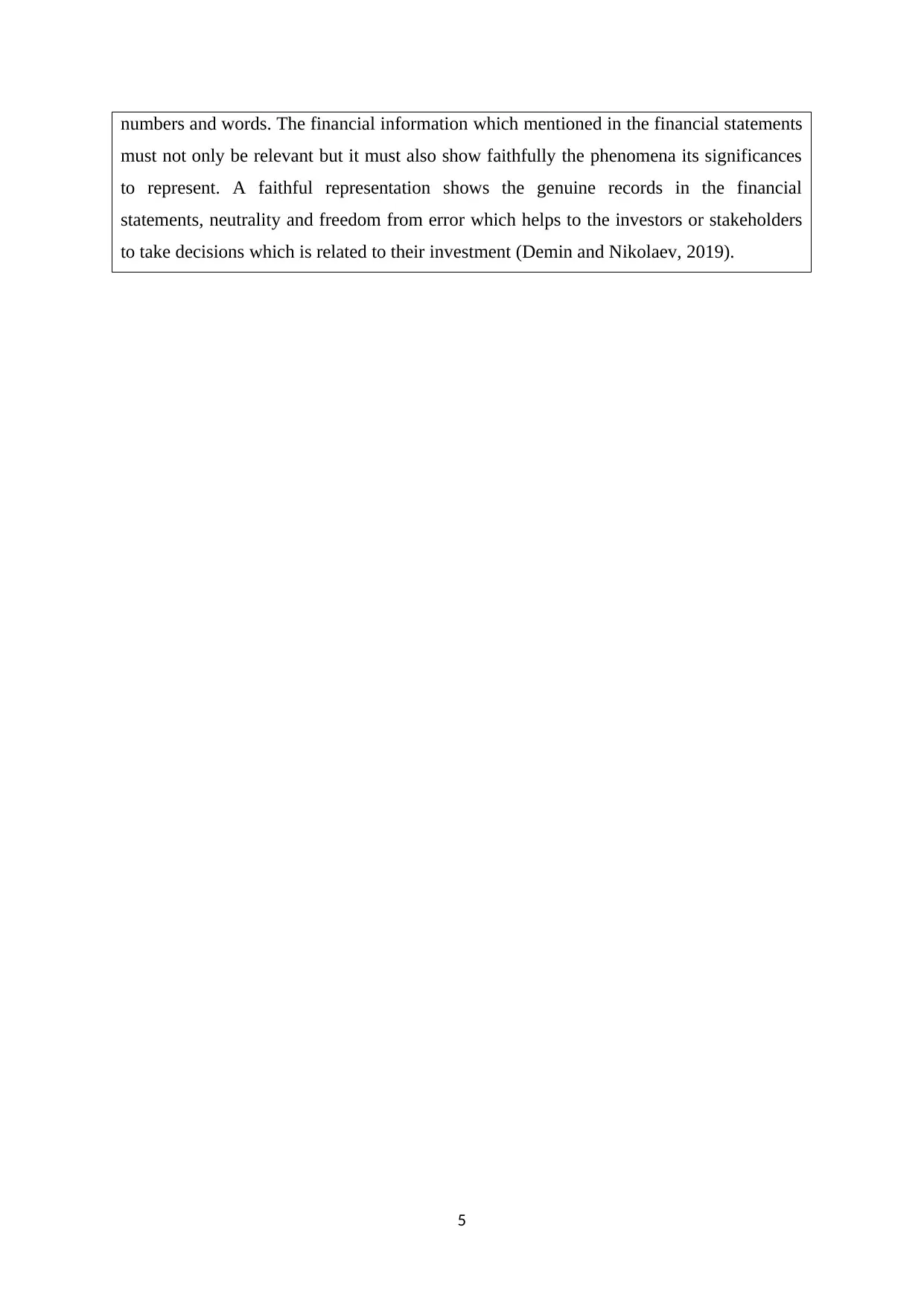
numbers and words. The financial information which mentioned in the financial statements
must not only be relevant but it must also show faithfully the phenomena its significances
to represent. A faithful representation shows the genuine records in the financial
statements, neutrality and freedom from error which helps to the investors or stakeholders
to take decisions which is related to their investment (Demin and Nikolaev, 2019).
5
must not only be relevant but it must also show faithfully the phenomena its significances
to represent. A faithful representation shows the genuine records in the financial
statements, neutrality and freedom from error which helps to the investors or stakeholders
to take decisions which is related to their investment (Demin and Nikolaev, 2019).
5
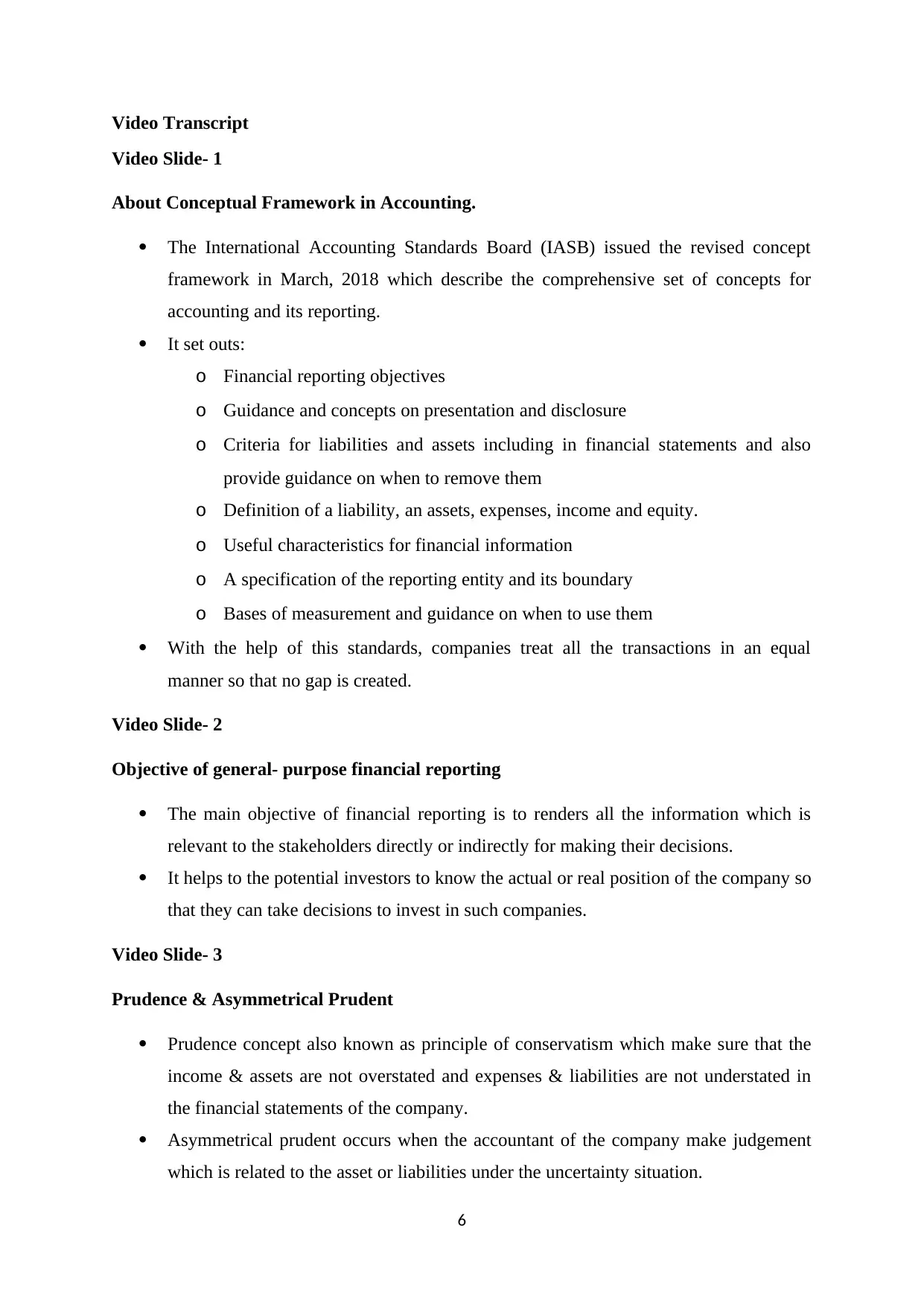
Video Transcript
Video Slide- 1
About Conceptual Framework in Accounting.
The International Accounting Standards Board (IASB) issued the revised concept
framework in March, 2018 which describe the comprehensive set of concepts for
accounting and its reporting.
It set outs:
o Financial reporting objectives
o Guidance and concepts on presentation and disclosure
o Criteria for liabilities and assets including in financial statements and also
provide guidance on when to remove them
o Definition of a liability, an assets, expenses, income and equity.
o Useful characteristics for financial information
o A specification of the reporting entity and its boundary
o Bases of measurement and guidance on when to use them
With the help of this standards, companies treat all the transactions in an equal
manner so that no gap is created.
Video Slide- 2
Objective of general- purpose financial reporting
The main objective of financial reporting is to renders all the information which is
relevant to the stakeholders directly or indirectly for making their decisions.
It helps to the potential investors to know the actual or real position of the company so
that they can take decisions to invest in such companies.
Video Slide- 3
Prudence & Asymmetrical Prudent
Prudence concept also known as principle of conservatism which make sure that the
income & assets are not overstated and expenses & liabilities are not understated in
the financial statements of the company.
Asymmetrical prudent occurs when the accountant of the company make judgement
which is related to the asset or liabilities under the uncertainty situation.
6
Video Slide- 1
About Conceptual Framework in Accounting.
The International Accounting Standards Board (IASB) issued the revised concept
framework in March, 2018 which describe the comprehensive set of concepts for
accounting and its reporting.
It set outs:
o Financial reporting objectives
o Guidance and concepts on presentation and disclosure
o Criteria for liabilities and assets including in financial statements and also
provide guidance on when to remove them
o Definition of a liability, an assets, expenses, income and equity.
o Useful characteristics for financial information
o A specification of the reporting entity and its boundary
o Bases of measurement and guidance on when to use them
With the help of this standards, companies treat all the transactions in an equal
manner so that no gap is created.
Video Slide- 2
Objective of general- purpose financial reporting
The main objective of financial reporting is to renders all the information which is
relevant to the stakeholders directly or indirectly for making their decisions.
It helps to the potential investors to know the actual or real position of the company so
that they can take decisions to invest in such companies.
Video Slide- 3
Prudence & Asymmetrical Prudent
Prudence concept also known as principle of conservatism which make sure that the
income & assets are not overstated and expenses & liabilities are not understated in
the financial statements of the company.
Asymmetrical prudent occurs when the accountant of the company make judgement
which is related to the asset or liabilities under the uncertainty situation.
6
⊘ This is a preview!⊘
Do you want full access?
Subscribe today to unlock all pages.

Trusted by 1+ million students worldwide
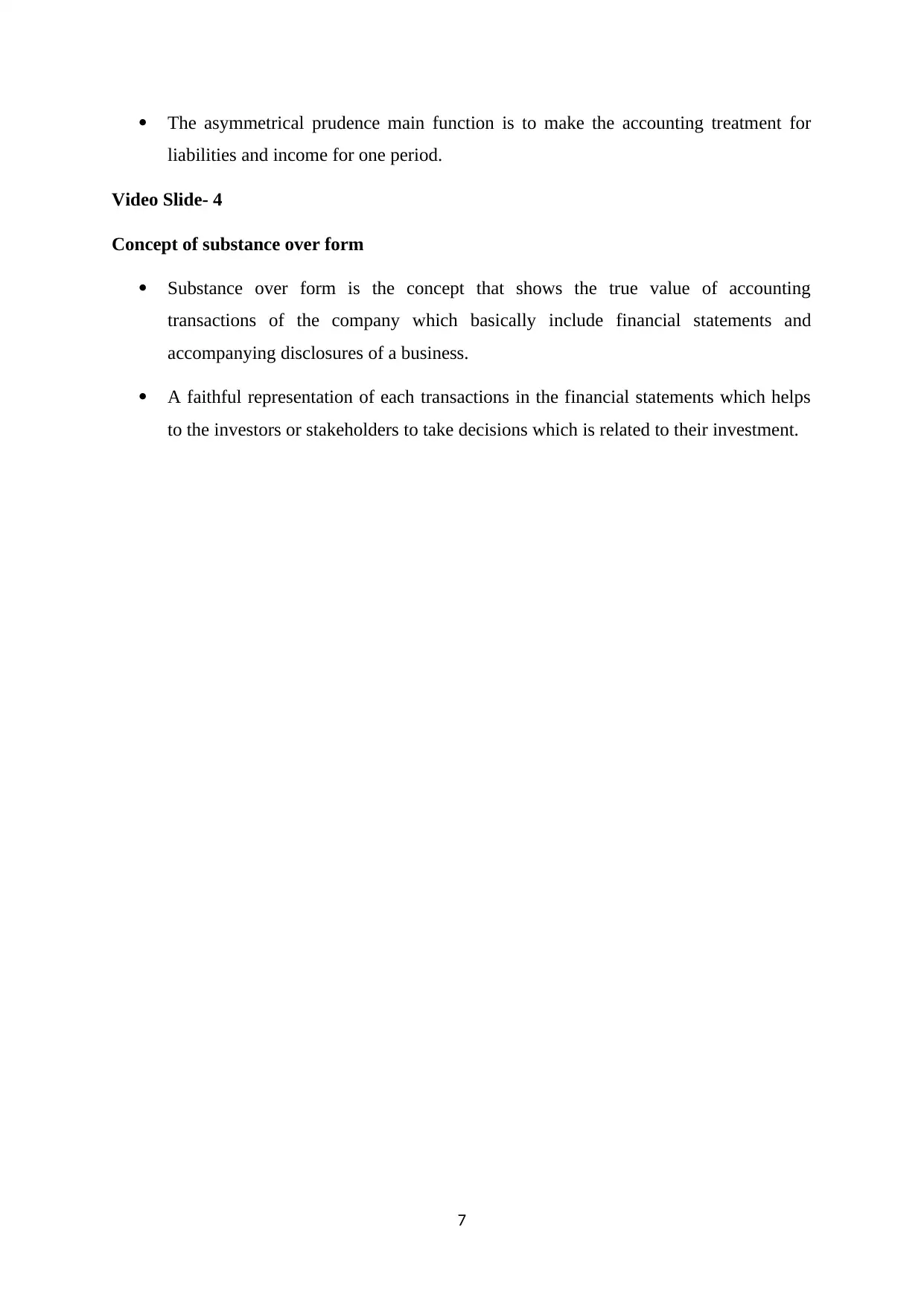
The asymmetrical prudence main function is to make the accounting treatment for
liabilities and income for one period.
Video Slide- 4
Concept of substance over form
Substance over form is the concept that shows the true value of accounting
transactions of the company which basically include financial statements and
accompanying disclosures of a business.
A faithful representation of each transactions in the financial statements which helps
to the investors or stakeholders to take decisions which is related to their investment.
7
liabilities and income for one period.
Video Slide- 4
Concept of substance over form
Substance over form is the concept that shows the true value of accounting
transactions of the company which basically include financial statements and
accompanying disclosures of a business.
A faithful representation of each transactions in the financial statements which helps
to the investors or stakeholders to take decisions which is related to their investment.
7
Paraphrase This Document
Need a fresh take? Get an instant paraphrase of this document with our AI Paraphraser
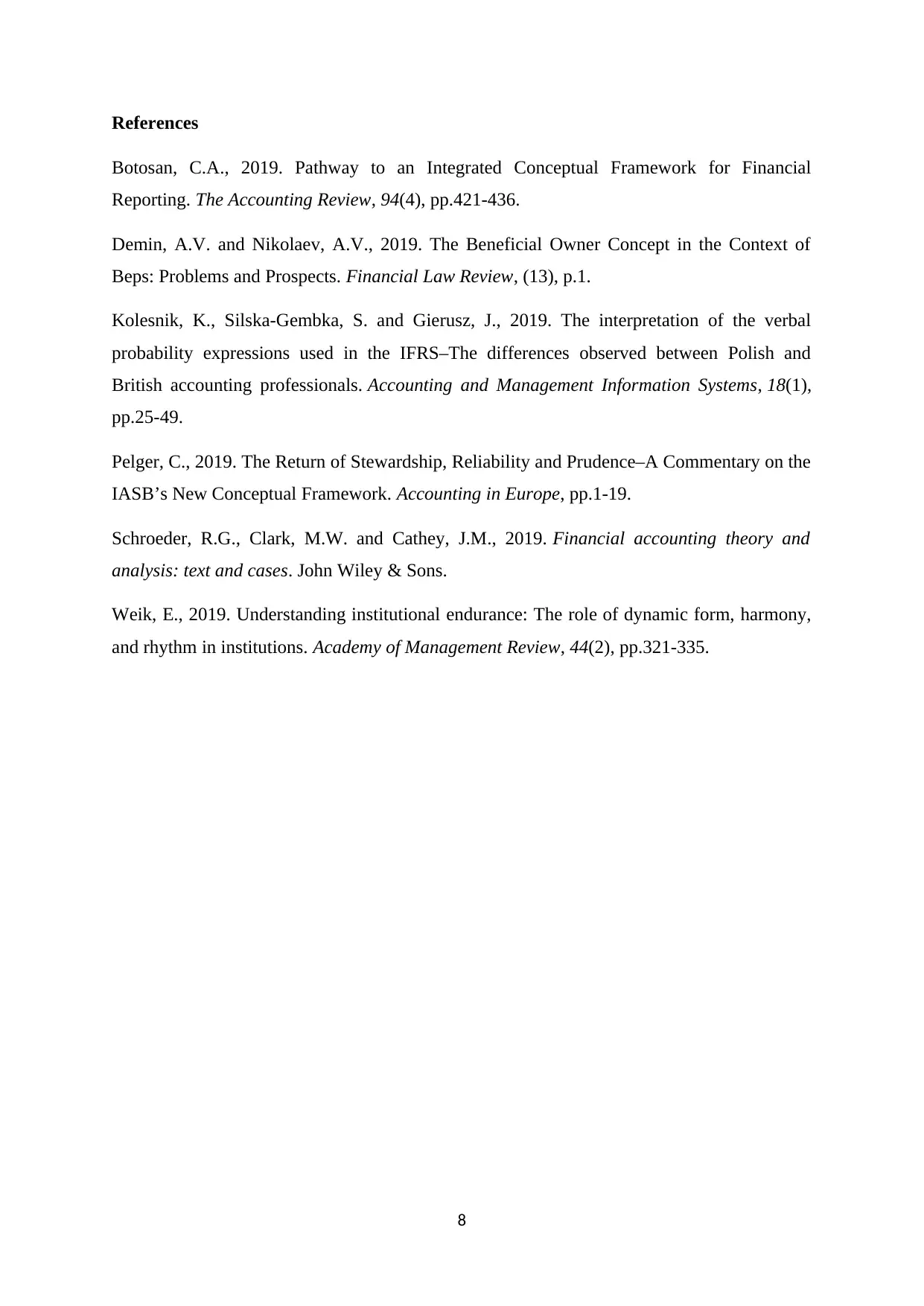
References
Botosan, C.A., 2019. Pathway to an Integrated Conceptual Framework for Financial
Reporting. The Accounting Review, 94(4), pp.421-436.
Demin, A.V. and Nikolaev, A.V., 2019. The Beneficial Owner Concept in the Context of
Beps: Problems and Prospects. Financial Law Review, (13), p.1.
Kolesnik, K., Silska-Gembka, S. and Gierusz, J., 2019. The interpretation of the verbal
probability expressions used in the IFRS–The differences observed between Polish and
British accounting professionals. Accounting and Management Information Systems, 18(1),
pp.25-49.
Pelger, C., 2019. The Return of Stewardship, Reliability and Prudence–A Commentary on the
IASB’s New Conceptual Framework. Accounting in Europe, pp.1-19.
Schroeder, R.G., Clark, M.W. and Cathey, J.M., 2019. Financial accounting theory and
analysis: text and cases. John Wiley & Sons.
Weik, E., 2019. Understanding institutional endurance: The role of dynamic form, harmony,
and rhythm in institutions. Academy of Management Review, 44(2), pp.321-335.
8
Botosan, C.A., 2019. Pathway to an Integrated Conceptual Framework for Financial
Reporting. The Accounting Review, 94(4), pp.421-436.
Demin, A.V. and Nikolaev, A.V., 2019. The Beneficial Owner Concept in the Context of
Beps: Problems and Prospects. Financial Law Review, (13), p.1.
Kolesnik, K., Silska-Gembka, S. and Gierusz, J., 2019. The interpretation of the verbal
probability expressions used in the IFRS–The differences observed between Polish and
British accounting professionals. Accounting and Management Information Systems, 18(1),
pp.25-49.
Pelger, C., 2019. The Return of Stewardship, Reliability and Prudence–A Commentary on the
IASB’s New Conceptual Framework. Accounting in Europe, pp.1-19.
Schroeder, R.G., Clark, M.W. and Cathey, J.M., 2019. Financial accounting theory and
analysis: text and cases. John Wiley & Sons.
Weik, E., 2019. Understanding institutional endurance: The role of dynamic form, harmony,
and rhythm in institutions. Academy of Management Review, 44(2), pp.321-335.
8
1 out of 8
Related Documents
Your All-in-One AI-Powered Toolkit for Academic Success.
+13062052269
info@desklib.com
Available 24*7 on WhatsApp / Email
![[object Object]](/_next/static/media/star-bottom.7253800d.svg)
Unlock your academic potential
Copyright © 2020–2025 A2Z Services. All Rights Reserved. Developed and managed by ZUCOL.





